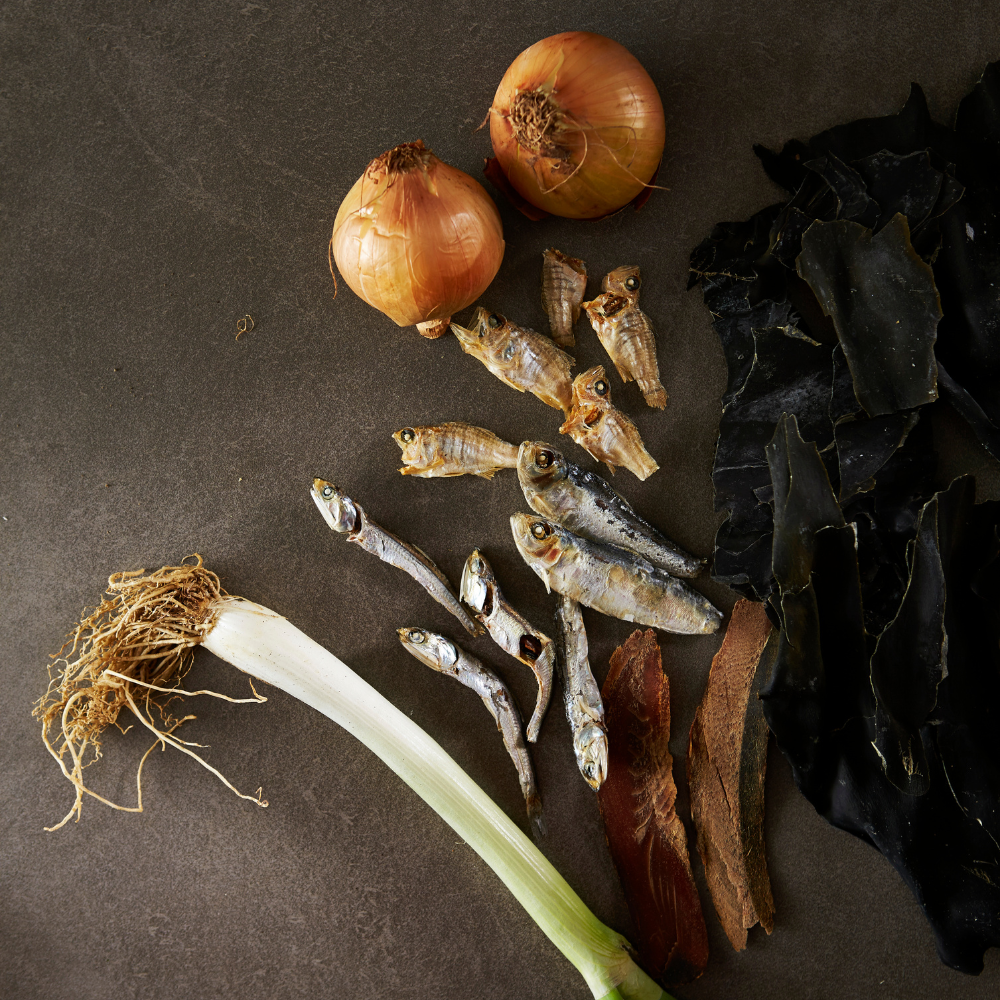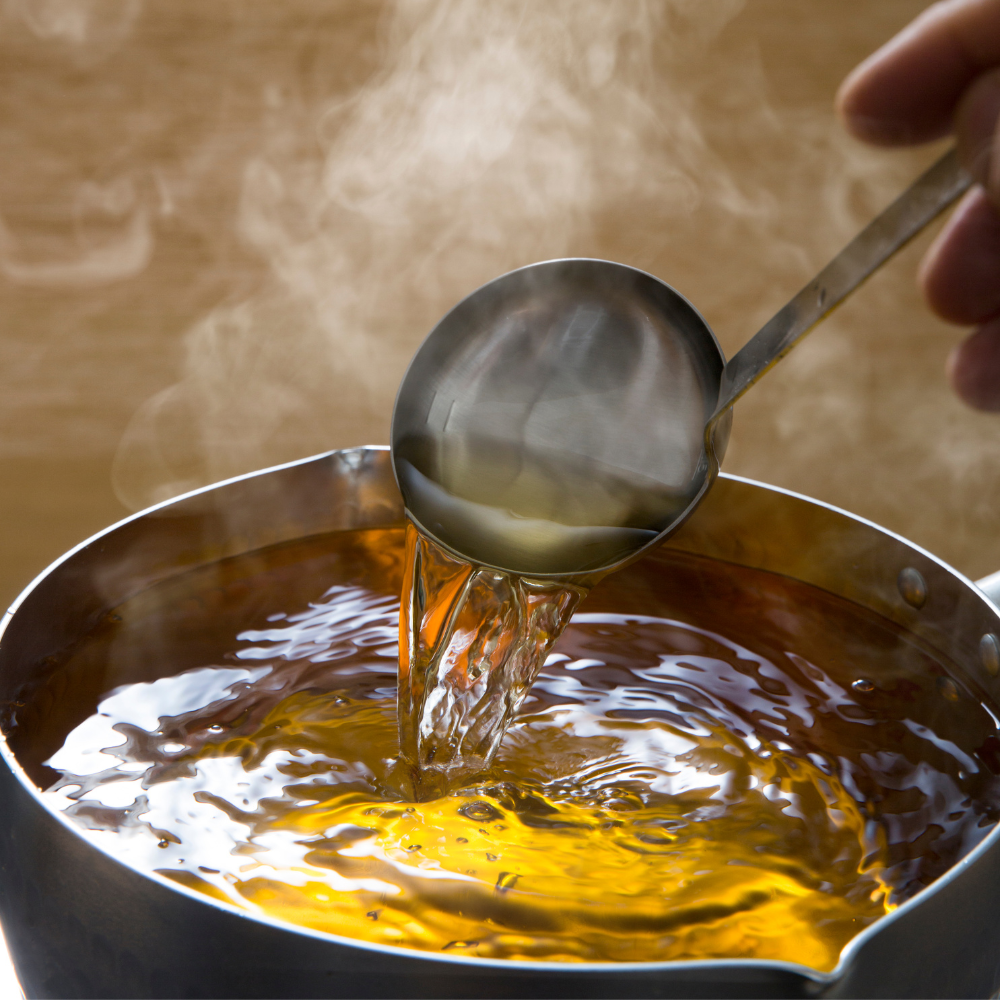How to Elevate Everyday Meals with Dashi

"Dashi is not a seasoning, but a base for cooking," says Shohei Miyajima about the Japanese stock that is quick to make, full of umami flavor, and endlessly versatile. Shohei is the manager of Brooklyn's Dashi Okume, a market dedicated to high-quality Japanese ingredients that comprise dashi. You can pick from 30 available ingredients at the market, customizing a dashi recipe and creating your own personal combination. Shohei joined HRN host Akiko Katayma on Japan Eats! to demystify dashi ingredients, reveal how to maximize umami flavor, and share inspiring ideas for incorporating dashi into your everyday cooking.
Dashi combines several umami-rich ingredients.
Dashi stock is a staple ingredient in Japanese cooking. It is made up of ingredients that have been cured and dried to concentrate their umami flavor. When the ingredients are rehydrated, the umami flavor is released into the stock, making it easier to use in cooking. The prep work for dashi ingredients has already been done outside the kitchen, Akiko says. Just boil the following ingredients for just 5 minutes, and you'll have something delicious in a flash:

1. Katsuobushi or bonito: dried fish flakes made from bonito, a tuna relative. Bonito takes at least one and up to six months to make.
2. Niboshi, also called iriko: small dried fish like sardines, anchovies, or mackerel. One tip for spotting the best niboshi? Shohei says some of the fish that he handles have open mouths, which means they were boiled when they were still cold and alive.
3. Kombu: a type of dried kelp, 90% of which is grown in Hokkaido. Dashi Okume has four types of kombu in stock to try: Rishiri Konbu, which is very savory and versatile; the full-bodied Makonbu; Hidaka Konbu, which is a stronger yellow color than other kelp; and Rausu Konbu, the 'king' of kombu with a rich aroma and a deep complex taste.
4. Shiitake mushrooms: deeply flavored mushrooms with a meaty and somewhat smoky flavor.
The golden ratio for dashi is said to be: 5:3:1:1.
Combining different sources of umami doesn't just have an additive effect on the stock, it's exponential. Shohei says your dashi will have eight times more umami when you use use 50% bonito, 30% niboshi, 10% seaweed, and 10% mushrooms.
While 5:3:1:1 may be the golden ratio, it doesn't mean you're locked into it. Some chefs play with this ratio, plus, if you're adding other sources of umami like miso or soy sauce to your final dish you may want to alter the dashi ingredients. There are regional variations of dashi in Japan from which to draw inspiration. In Osaka and the western part of Japan, there is a greater supply of kombu; in Tokyo and the eastern regions there is a preference for more bonito flakes; and in Kyoto shiitakes' flavor is very popular. 
There are three types of umami that the perfect dashi ratio can maximize.
1. Inosinic acid: found in bonito and niboshi. It's also in steak and other meat.
2. Glutamic acid: present in kelp, as well as tomatoes and onions.
3. Guanylic acid: plentiful in shiitakes and other mushrooms.
Knowing what foods have which umami type helps to balance flavors while cooking and adjusting for flavor. For instance, Akiko says if you have another mushroom on hand, you can use that as a source of guanylic acid and umami instead of shiitakes.
So, how to put all this dashi knowledge to use?
The point of dashi is to use it every day and its versatility makes that effortless. You can drink dashi on its own; create a delicious miso soup simply by adding miso, tofu, and seaweed; or add it to an omelet any morning at home. Cook soba noodles in dashi or even use the stock to simmer vegetables.
Akiko emphasizes that dashi's flavor is subtle and won't change the whole dish. "It's an elevation of the bottom line," Akiko says, "my go-to rescue ingredient." She also recommends putting it in your rice cooker with plain sushi rice. "That was a recent—and amazing—revelation, and now I can't stop!"
If you're looking for some beautiful Japanese tableware to accompany your newest creations in the kitchen, Korin has your back. Korin is proud of their Japanese culture, but their glass and tableware can be used for any cuisine, restaurant, or home kitchen. Their unique store in Manhattan is home to perhaps the most extensive collection of Japanese chef knives in the world - including Japan. Thanks to Korin for supporting HRN and making this article and episode of Japan Eats! possible.
Listen to the podcast interview here or find Japan Eats! wherever you get your podcasts:










